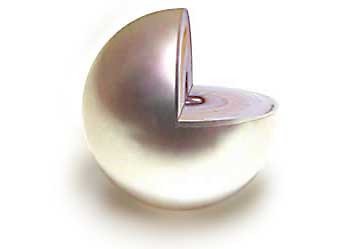PEARL QUALITY
|
|
• Freshwater pearls take 3-6 months to mature in pools, streams and lakes ...Click for more details |
|
|
• Akoya pearls take 2 years to mature on the coast of the Sea of Japan ...Click for more details |
|
|
• South Sea Pearls take 2-5 years to mature in the South Pacific Ocean ...Click for more details |
|
|
• Tahitian pearls take 2-5 years to mature in Tahiti’s volcanic coral reefs in the Pacific. ...Click for more details |
GENUS (TYPES)
The pearl family can be divided into two groups:
Freshwater Pearls and Saltwater Pearls
- Freshwater pearls: there is only one variety.
- Saltwater pearls: there are three types - Akoya Pearl, Tahitian Pearl and South Sea Pearl. South Sea and Tahitian Pearls are known as ‘Ocean Pearls’.
Oysters that grow in the sea have a higher risk of disease as they have to cope with the natural environment around them. Living in a natural environment gives the pearl an extra lustre and higher quality nacre (mother of pearl) due to the minerals and beneficial organisms it takes in from the water. This is an important point for the Oyster Pearl brand. We choose our oysters with great care so we can offer our customers the most lustrous pearls with the best quality nacre (mother of pearl).
In oyster cultivation, different quality pearls are produced by the oyster according to the area where it grows. These pearls come in many different varieties, from those with a perfectly round surface to those with average lustre that are about the size of a grain of rice. *One oyster can only produce a pearl once or twice during its entire life.

PEARL SIZES
An important factor in the cost of a pearl is its size. For this reason, they are measured with a special millimetre diameter-gauge.
The price of a pearl increases incrementally in considerable leaps along with every increase in size. Just as an example, the cost of one 18 mm saltwater pearl starts from $13,000 due to the high demand, and prices for pearls of a greater quality are inestimable.
Along with other important factors that affect the value of a pearl, the pearl’s size and genus are significant points.
A mere 1mm difference in the pearl’s size makes a huge difference to its appearance and to its price.
At Oyster Pearl, we always have the best interests of our customers in mind as we select the finest quality pearls.

MOTHER OF PEARL (NACRE)
- Mother of pearl is a natural calcium carbonate based substance that is secreted by the oyster to protect its delicate structure against damaging shell particles and parasites. The inner surface of the oyster shell is covered in the same nacre.
- Large pearls are more lustrous due to their greater number of nacre layers, but the more the oyster grows, the greater chance there is of the pearl becoming misshapen. This risk contributes to the higher price tag on large pearls.
- Successive nacre layers give the pearl’s outer surface more lustre and also make it more resilient.
- A pearl with fine layers of nacre will take much longer to wear away.

PEARL SHAPE
- A pearl’s shape is affected by a number of factors, the chief one being the delicate structure of the oyster. The oyster tries to protect its delicate structure against foreign bodies, such as pieces of shell, grains of sand and parasites.
- Therefore, perfectly round pearls are a rare find. The more an oyster has protected itself against foreign bodies and the rounder the pearl it has produced, the greater its value. The rarity of finding a perfect pearl increases its value.

PEARL LUSTRE
Lustre is one of the most important factors distinguishing a high quality pearl from the others.
- Lustre is created by the degree of brilliance reflected from the pearl’s surface and the light refracted from the layers immediately below it.
- The shine of a high quality pearl is both deep and shimmering. A high value pearl has an incredible brilliance, but its symmetry and the quality of its surface are equally important.
- You can easily see your own reflection in the surface of a top quality pearl.
- A low quality pearl has a dull and chalky appearance.

PEARL SURFACE
- The more unblemished, unpitted, unmarked and clear the surface of a pearl is, the greater its value. As tiny blemishes and pits affect the reflection and shine, they also lower the pearl’s value.
- You can see that the reflection in top quality pearls is very sharp and mirrorlike.

PEARL COLOURS
- While pearl colour is not necessarily a factor in their quality or price, they come in a range of colours from white to black and numerous shades in between.
Naturally occurring colours:
- White
- Cream
- Peach
- Green
- Honey Gold
- Black
There are intermediate shades between these main colours, each containing a myriad of tones and mystical colour changes.
Choice of colour depends completely on personal taste; but pink and its overtones tend to suit fairer skin, while cream and gold tones are more flattering for darker skin. The meanings embodied by these colours give the pearl a more spiritual significance, making it a gem that you will always want with you. As an example: white is for purity, cream is for happiness, peach is for love and black is for wisdom.






